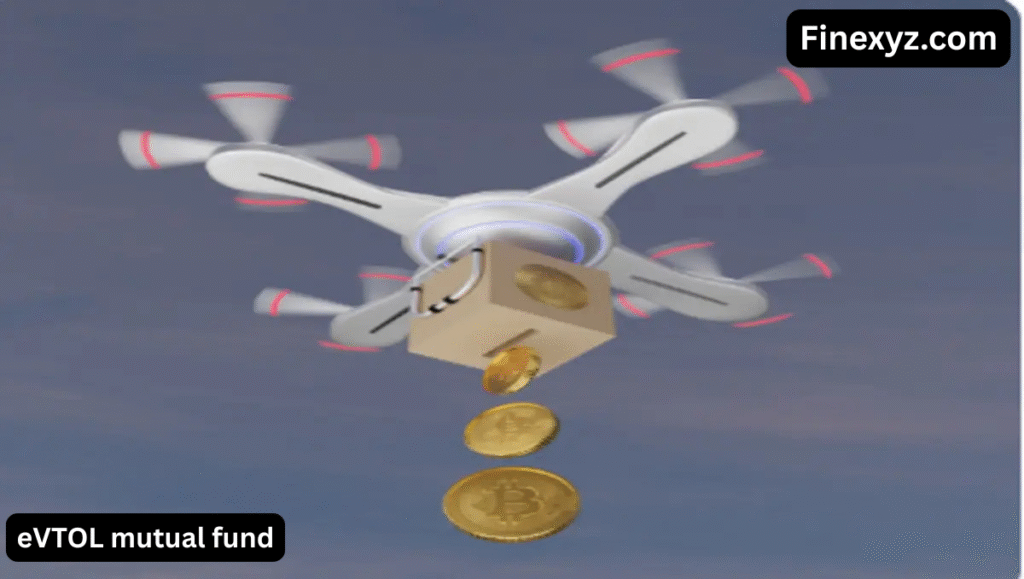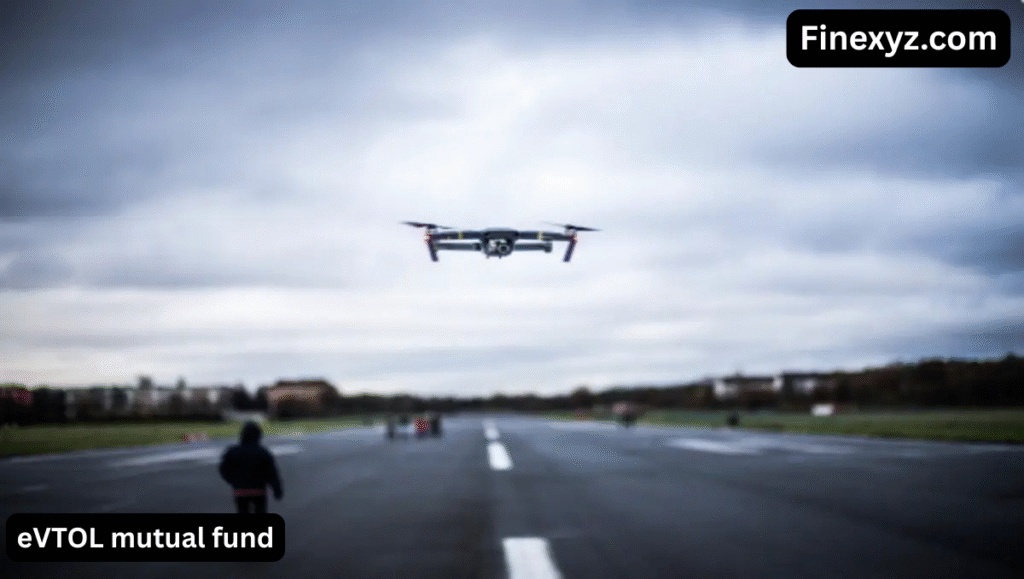Welcome to the fascinating world of eVTOL mutual funds, where innovation meets investing opportunities. As electric vertical takeoff and landing (eVTOL) aircraft transform urban air mobility, investors are looking to capitalise on this burgeoning sector. In this piece, we’ll look at how eVTOL mutual funds can help you prepare for the future of transportation.
What Are eVTOL Aircraft?
Before delving into the potential of eVTOL mutual funds, it’s important to understand what eVTOL planes are and why they’re garnering so much interest. eVTOLs are electric aircraft that can take off, hover, and land vertically. Unlike traditional aeroplanes, which require runways, eVTOLs obtain vertical lift via electric engines and rotors, making them perfect for urban situations. Because of their tiny shape, they can access regions that would be impossible for conventional aircraft to reach.
eVTOL technology is likely to transform how we think about transportation, particularly in densely populated urban areas. They promise to provide rapid, efficient, and sustainable air transport, potentially alleviating traffic congestion, lowering carbon emissions, and improving mobility.
eVTOL Mutual Funds: An Introduction
As the eVTOL sector expands, numerous mutual funds have formed to invest in firms developing eVTOL technology. These funds aggregate investor money and invest in eVTOL-related firms including as manufacturers, battery producers, and software developers.
Mutual funds are a popular investment option because they diversify portfolios and reduce risk for individual participants. eVTOL mutual funds expose investors to a diverse range of companies developing eVTOL technologies. This is a unique opportunity to capitalise on the growth potential of this developing sector without placing all of your eggs in one basket.
Why Are eVTOL Mutual Funds Gaining Popularity?
The appeal of eVTOL mutual funds arises from the prospect of substantial profits and the promise of a completely new method of transportation. Several factors motivate interest in these funds:
1. Innovation within the aviation industry
The aviation sector has traditionally been dominated by major, established aircraft manufacturers. However, the advancement of eVTOL technology is challenging the current quo, with new competitors entering the market. Companies such as Joby Aviation, Lilium, and Vertical Aerospace are making major steps towards bringing eVTOLs to market, with each promising to alter urban mobility.
Investing in eVTOL mutual funds allows investors to benefit from this innovation while also capitalising on the growing air mobility market. This innovation-driven growth offers tremendous upside potential for investors prepared to take a long-term perspective.
2. A Sustainable Future.
Electric propulsion is at the foundation of eVTOL technology, making these aircraft significantly more ecologically benign than typical gas-powered aircraft. With growing worries about climate change and air pollution, eVTOLs provide an answer to some of the most serious environmental issues.
As governments around the world establish more ambitious sustainability goals, eVTOLs are likely to play an important role in lowering carbon emissions. Investors interested in sustainable, green technologies are likely to consider eVTOL mutual funds for their portfolios.

3. Urban Air Mobility (UAM) Market Potential
Urban Air Mobility (UAM) refers to the use of eVTOLs for a variety of applications, including air taxis, commodities delivery, and emergency response. As cities become more congested, UAM provides a means to avoid ground-level traffic and deliver faster, more efficient transit.
Morgan Stanley estimates that the UAM market will be valued more than $1 trillion by 2040. This significant growth potential has attracted both institutional and retail investors, resulting in increased demand for eVTOL mutual funds.
4. Technological Advances and Partnerships
The eVTOL sector is quickly growing, with ongoing technology breakthroughs boosting the aircraft’s performance and feasibility. Companies are attempting to improve energy efficiency, reduce noise levels, and ensure the safety of eVTOLs, making them more desirable to both consumers and regulators.
Furthermore, established companies, including automakers and aerospace conglomerates, are increasingly collaborating with eVTOL startups to hasten development. Toyota and Boeing, for example, have invested in eVTOL developers, indicating that they believe this technology has a bright future. These agreements boost the industry’s legitimacy and growth possibilities, making eVTOL mutual funds more appealing to investors.
Key Companies in eVTOL Space
Several firms are at the forefront of eVTOL development, with several of them represented by eVTOL mutual funds. Some of the prominent participants in the market are:
1) Joby Aviation
Joby Aviation is a well-known company in the eVTOL field, creating an all-electric vertical takeoff and landing aircraft capable of carrying up to four passengers. The business has received enormous funding and has reached important milestones, including a successful test flight in 2020. Joby aims to launch commercial air taxi services in the mid-2020s.
2) Lilium
Lilium is a German eVTOL company working on a five-seater aircraft suitable for both short and long-distance urban air mobility. The startup has received widespread notice for its creative design, and it has already attracted high-profile investors. Lilium is developing a network of eVTOL air taxis in key cities.
3. Vertical Aerospace.
Vertical Aerospace is another important player in the eVTOL space, producing electric aircraft for urban air mobility. The business has formed collaborations with major aerospace and technology companies, including Rolls-Royce and Honeywell, to bring their eVTOL aircraft to market.
4) Archer Aviation
Archer Aviation, based in the United States, is developing an eVTOL aircraft with the goal of alleviating urban traffic congestion. The company has declared ambitions to launch electric air taxi services in numerous major cities in the next years.
Risks and Challenges for eVTOL Mutual Funds
While eVTOL mutual funds have a lot of potential, there are some dangers to consider:
- Regulatory hurdles: eVTOLs must follow severe aviation laws, and it is unclear how quickly these regulations will be implemented. Regulatory delays could limit the industry’s growth and harm the performance of associated mutual funds.
- Technological Uncertainty: Despite tremendous advances, the technology that powers eVTOLs is still in its early stages. There is no guarantee that the participating companies will be able to overcome the technical problems of battery life, safety, and noise reduction.
- Market Adoption: While eVTOLs show enormous promise, broad adoption remains a long way off. Urban air mobility has substantial challenges, including public acceptance, infrastructure development, and operating costs.

Conclusion
eVTOL mutual funds offer a unique opportunity to invest in the future of air transport. As the business evolves and technical improvements arise, these funds may provide considerable long-term development opportunities. However, as with any growing industry, eVTOLs carry hazards, and investors should carefully examine their risk tolerance before plunging in. With the correct approach and a focus on long-term growth, eVTOL mutual funds might be a great addition to a diverse investment portfolio, allowing investors to profit from the future of urban air mobility.
Read More
Faq’s
1. What are e-VTOL mutual funds?
eVTOL mutual funds invest in firms that create electric vertical takeoff and landing aircraft, providing exposure to the expanding urban air mobility market.
2. Why should you invest in eVTOL mutual funds?
These funds provide the potential for substantial profits by investing in the future of air travel and mobility.
3. What are the risks?
Regulatory obstacles, technological concerns, and slow market adoption might all have an impact on the sector’s growth.
4. Which corporations dominate the industry?
Joby Aviation, Lilium, Vertical Aerospace, and Archer Aviation are some of the leading eVTOL businesses.
5. When will eVTOL aircraft become available?
Commercial eVTOL aircraft are projected in the next 5 to 10 years, depending on regulatory permissions and technology.

2 thoughts on “eVTOL Mutual Funds In 2025”